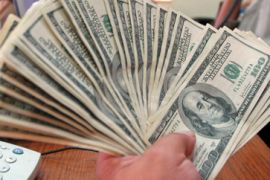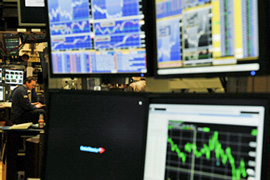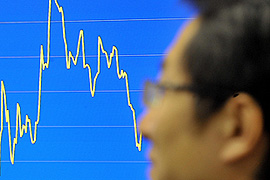Whither the US dollar?
Economic analyst says there may be little Washington can do to stop its currency slide.

 |
| Timothy Geithner, the US treasury secretary, wants a strong dollar but has taken no steps to defend it against its downward slide in international markets [EPA] |
During a recent visit to Tokyo, Timothy Geithner, the secretary of the US treasury, said that a strong dollar is “very important” to Washington, even as the American currency continued its noticeable depreciation.
This is a very curious statement as it seems to indicate that the US treasury is going to defend the dollar from any further slide in the near future. But this is highly unlikely as the US treasury does not have a history of intervening in foreign exchange markets.
Keep reading
list of 4 items‘We need you’: Solomon Islands’ support for US agency’s return revealed
Why are nations racing to buy weapons?
Parallel economy: How Russia is defying the West’s boycott
It is true that the treasury’s Exchange Stabilisation Fund (ESF) can be used to prop up the dollar, but it has never really been used for that purpose. The ESF, which right now has about $50bn, was originally created by the Roosevelt administration in the early 1930s to deal with currency upheavals as the Gold Standard was being dismantled.
The ESF was used only once in international financial markets and that was to defend the Mexican peso in 1994.
Therefore, the treasury’s use of the ESF to defend the dollar can be ruled out.
In any case, it would take a lot more than $50bn to stabilise the greenback if there were to be a speculative attack on the dollar, like there was against the British pound in 1992.
On September 16, 1992, the UK withdrew the pound sterling from the European Exchange Rate Mechanism (ERM) after short selling in global markets brought the value of the British currency below its agreed lower limit.
Liquidity and the Fed
 |
| The Fed has been providing banks with funds at nearly zero per cent [EPA] |
The US Federal Reserve (popularly known as the Fed) is also unlikely to be defending the dollar any time soon. To prop up the currency, the Fed would have to buy back dollars which would require that the US offer euros, British pounds and Japanese yens in exchange.
The Fed does not have much foreign currencies in stock because the US has been running trade deficits continuously for a long time now.
The fact that the Fed does not have a war chest big enough to intervene credibly in the foreign exchange market on behalf of the dollar, paradoxically, discourages short and swift “shark attacks” – the massive selling of dollars by speculators in a very short span of time.
Speculators need some entity to bet against, and typically such opposition is provided by a central bank, such as the role the Bank of England played in its defence of the pound in 1992.
In fact, the Fed is at present much more interested in supplying dollars than in buying them. It has committed itself to providing liquidity to the banks at rates closer to zero per cent.
The banks can then presumably lend this money to households and firms at much higher interest rates and pocket the difference. For example, the mortgage rate in the US has been hovering around five per cent.
While getting near-free money from the Fed and then being able to lend it at five per cent provides enormous potential for profits (and large bonuses and salary increases for top management), it also reflects the high risk of default the banks perceive as a threat, given the defaults that have taken place on past lending.
The Fed creates this cheap money by paying for US government bonds that it buys from the public. Thus, the Fed ends up financing US government debt, albeit indirectly. Hence, a lot of the bailout money for AIG, Fannie Mae, and GM, has been indirectly financed by money created by the Fed.
‘Too much money?’
However, could the creation of all this money lead to inflation? After all, was it not the danger of rising inflation that principally fuelled the dollar’s downward spiral?
These concerns stem from the simplest, yet best-known economic theorems: inflation is caused by “too much money chasing too few goods”.
While it is true that the treasury and the Fed acting together are creating a lot of money, we are not even close to an excessive demand for goods and services in the US. Sales are down significantly across the board.
Most households get frequent solicitations from Direct TV, the phone company, or the cable company offering high-definition connections at highly discounted rates; airline fares have declined, if not collapsed. It is easy to find seats in movie theatres and restaurants as there are no people lining up to get in.
The deals that auto companies are offering, be they American, Japanese or Korean, are extremely lucrative to the consumers. All round, it feels more like the economy is producing too many goods, not “too few”.
If inflation is not a real danger then why is the dollar depreciating? Since 2002, the US government deficits have been mounting as have the trade deficits. These two trends have brought about a long-term average decline of the dollar in spite of several short-term upswings.
Part of the new dollar crisis can be attributed to new monetary policy from the Fed which is to lend money to the member banks in the US at virtually 0 per cent. This has enabled these banks to invest some of that money in the high-performing emerging economies in Latin America and Asia where the rate of return is much higher than what can be earned in the US. This is called the dollar “carry” trade.
Finally, the more recent and conspicuously sharper decline of the dollar has also been due to diversification on the part of central banks from the dollar to gold, euros, and the yen. India’s central bank, for example, recently used $6.7bn from its reserves to buy gold.
China’s power
 |
| US trade deficit with China has given Beijing power to determine the dollar’s strength [AFP] |
The foreign institution which matters the most regarding the value of the dollar, by far, is the central bank of China, the People’s Bank of China (PBC).
Ever since China joined the international monetary system in the late 1980s, the PBC has pegged the yuan to the dollar, and only recently allowed the yuan to appreciate slightly.
The implication of China’s fixed exchange rate policy has been that on a daily basis the PBC has been able to reap all the excess dollars flowing into China in the form of trade surplus with the US.
Instead of holding on to these reserve dollars in the form of cash, the PBC has invested them in interest-paying US government bonds.
The accumulation of the US government bonds in the coffers of the PBC, including those with the central bank of Hong Kong, is now valued at well over a trillion dollars. The PBC has, for all practical purposes, become a lending agency to the US government.
But China has lately started becoming very nervous about its dollar holdings because of the sharp increase in the recent US government deficits. The deficit for the fiscal year 2009-10 could be close to $2tn.
However, as long the Chinese authorities want to manage the exchange rate of the yuan to the dollar, they are stuck with the status quo and will have to continue absorbing the dollar surpluses.
Washington feels stuck too. It realises that it is the Chinese authorities who control the floor value of the dollar. No wonder, then, that Geithner made reassuring statements about the US government’s commitment to a “strong dollar” when Barack Obama, the US president, visited China last week.
Adhip Chaudhuri is a professor of international economics at Georgetown University in Washington, DC.